Demonstrating First-Hand Experience in YMYL Niches
Key Takeaways
- Google prioritizes YMYL (Your Money or Your Life) content, focusing on real, accurate knowledge and lived experience to ensure trustworthiness and reliability.
- Demonstrating E-A-T (Expertise, Authoritativeness, Trustworthiness) through visible firsthand experience in content enhances credibility and user trust.
- Including real photos or videos related to the content topic, such as before-and-after images or work-in-action shots, helps establish expertise and authenticity to readers and search engines.
“Your Money or Your Life” (YMYL) refers to topics that can directly impact a person’s health, finances, safety, or overall well-being.
Since the consequences of misinformation are serious, Google holds YMYL pages to a much higher standard. That is, it looks for signs that the content around those topics is real, accurate knowledge and lived experience.
Google (and readers) will not trust pages that are without proof of experience. And this makes E-E-A-T (experience, expertise, authoritativeness, and trustworthiness) a lot more important.
In this article, we will focus on the first one, experience, and how to demonstrate it in your content for both readers and search engines.
How to Visibly Demonstrate First-Hand Experience in Content
If a reader can’t tell who wrote the piece and why they’re qualified within 10 seconds, the page is failing EEAT. Google looks for signs of that, too, and the following methods help you show that your content is based on actual expertise and real user stories:
1. Include real photos or videos of the author at work
Every reader wants to read from a surgeon who has done some work on brain surgery. The same way you want to learn about coping mechanisms from an actual therapist who has helped others through their anxiety issues.
Your content is more credible when readers see that you have done the work and are sharing from your experience.
When you write, you can share pictures of those you’ve helped (with their permission) or issues you’ve resolved and explain how you have done it.
For example, if you have a dental clinic, share the before and after pictures of specific treatments to help readers understand what their teeth can look like after a specific treatment you’re writing about.
Here’s an example of a veneer treatment from a dental clinic in New York:

Showing real photos of you at work extends to when you review products.
In an article about best sleep masks on Healthline, the author wrote that she used many masks before she could recommend the two she’s holding.

She went on to write her personal take on them, details on how they work, and the pros and cons of each.
Going this extra mile makes a lot of difference, especially for a medical product where people rely on the reviewer to make a purchase decision.
Next,
2. Share personal narratives or case studies
Sharing personal experience is a good way to influence people’s decisions. First-hand stories turn abstract advice into a more concrete and believable experience because you have lived it.
For example, this nutritionist wanted to study what happens when you try a 16-hour intermittent fasting because it’s a common phenomenon in the weight loss industry.
Rather than write a theoretical article about it, she wrote about her experience to answer the common questions those who want to try intermittent fasting have.

In her article, she pondered on questions about diet and how best to undertake the process (including whether to take coffee).
She wrote answers about what intermittent fasting does to the body, the type of coffee to take (no sugar), and other diet compromises to make. This way, she shows knowledge and experience which will make readers trust her more.
However, it doesn’t have to be your experience every time.
This article on how startups get funding by Barbara Thau on the Chamber of Commerce shows us that. New founders always want to know how to get funding for their business ideas, so they interviewed five startup founders who have received tens of millions from investors.

Throughout the article, she quoted them, paraphrased their experience (and words), and shared helpful advice that can help new startup founders.
All these point to the fact that if you don’t have specific experience in a topic, you can still write on the topic. You need to interview relevant subject matter experts (SMEs), lead with their narrative, and explain how your readers can take action (and see results) just like your SMEs did.
This type of content is relatable, trustworthy, and can increase your credibility as an author and a website (or brand).
3. Write in first-person when relevant
When Groove HQ tested writing new introductions with personal anecdotes, they saw over 300% more readers, compared to a post without storytelling.
People can tell when an author has real experience. It shows in the details, tone, and structure of the story. Instead of just repeating abstract facts, personal narratives make the topic easier to follow and more believable.
For instance, when people search for “Ketogenic diet for weight loss, this article about someone who tried keto for 30 days pops up:

In it, she started with why she avoids diets and eating regimens, which may also reflect most readers’ experience. Right out the gate, she’s already relatable.
She then went on to write about what to expect, what worked, what didn’t, and how she felt throughout the 30-day keto diet.
This approach and structure makes this piece more useful than a generic list of keto tips because it answers the questions readers are really asking—what is this actually like? Not just what is keto diet and how can I do it.
In some cases, you can also show experience and expertise by showing your credentials.
4. Add an author bio with real credentials
Readers want to know who they’re reading when it comes to topics that involve health, finance, or legal matters. An author bio helps establish that the person behind the content is qualified to speak on it and has the experience to back it up.
Keep the bio short on the page, but include a link to a full profile with more detail. Websites like Bankrate do this well, with clickable author names that lead to dedicated bio pages listing qualifications and other articles.

Valid credentials also increase visibility on the search results. This is because Google recognizes authors and trusts the authority they’ve built across websites. This then helps increase the “credibility of other websites they feature on.”
5. Implement author-specific structured data
Author schema is a code you deploy to inform search engines about an author. Once you’ve set it up, search engines may display all available information, including a short bio and social media profiles, when a user searches for the author online.
For example, when you search for “Dave Ramsey,” a well-known financial advisor, you’ll see a summary of information about him from his webinar and bio to his social media profiles.
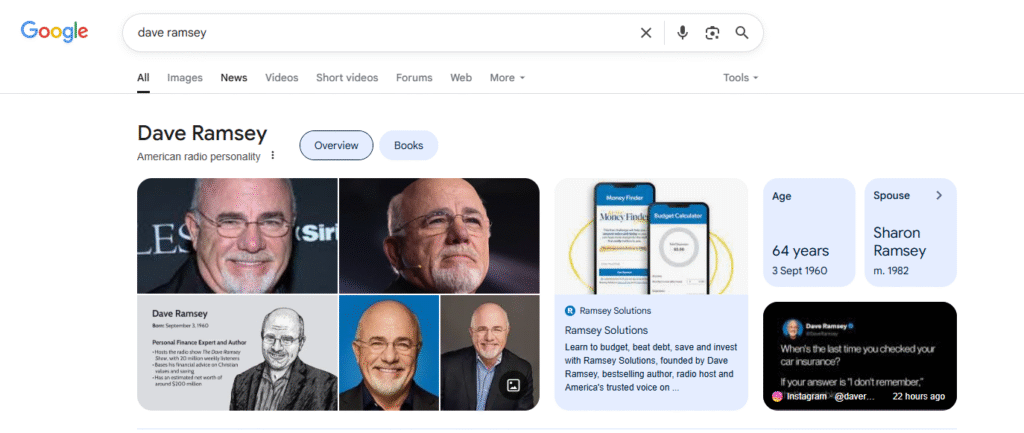
Here’s more about him:
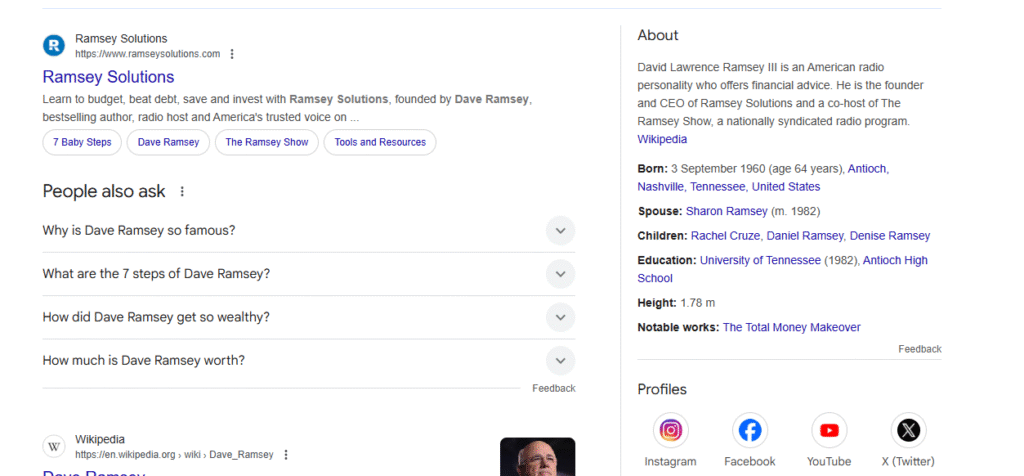
Google doesn’t display this kind of rich snippet for all authors on the Internet. But when you incorporate the author schema to your website, search engines can scan your page to evaluate the author’s reputation and credibility.
This is helpful for E-E-A-T. You also get points from readers for providing expert-written content.
Here’s how to add author schema to your page:
- Add author properties to the script section of your author page
Google recommends that you add the author.name, author, url, and describe the author type. The URL is the web page that is dedicated to the author. It can be their social media, website, or about me page.
The author type should be “person” when you want to attribute the article to a person and “organization” when you want to dedicate authorship to an organization.
You can also substitute the URL for a sameAs property; Google has no issue using either to define authors.
- Stick to author schema markup best practices
Here are some SEO best practices to ensure your author schema works right:
- If the article has many authors, place them in different author fields to ensure each author gets recognized.
- When writing the author schema, don’t stop at the author’s name; add a valid URL or sameAs property to provide sources for credibility.
- If you want to publish the article’s author as an organization, set the URL to the organization’s homepage.
- And finally, run the page through Google’s schema markup test to ensure your code works right.
Here’s a snapshot of a good author schema code:

6. Add a “reviewed by” caveat for regulated topics
Pages on medical, legal, or financial advice should show that the content has been reviewed by a qualified expert. It helps build trust with readers by demonstrating that the information is accurate and safe to follow.
FindLaw includes a legal review note on its articles. When a lawyer reviews a page, the article shows their name with “Esq.” to confirm their role.
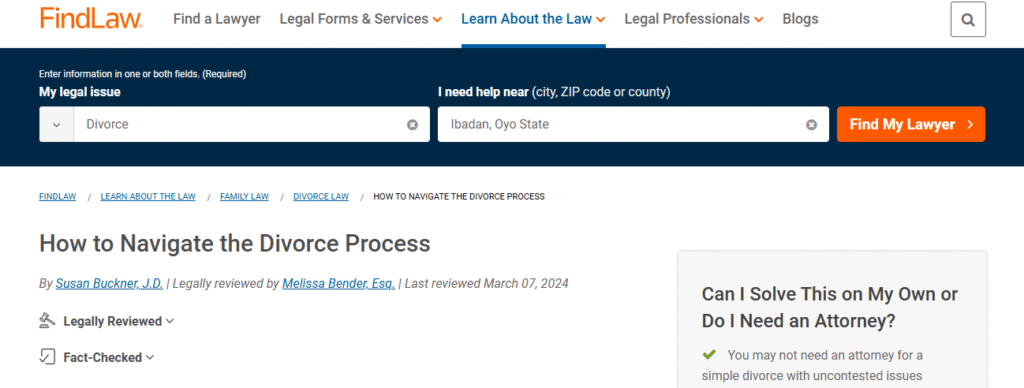
Healthline does the same for health content, often noting that a doctor has reviewed the article for medical accuracy.
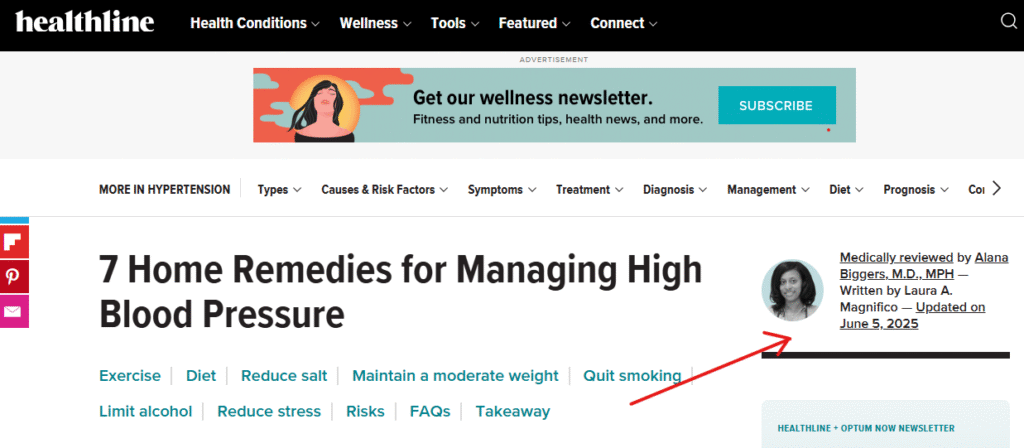
You can also add a short “Reviewed by” line at the end of the article. Include the reviewer’s name, title, and credentials. If the topic is highly sensitive, consider adding a full bio or linking to one.
For health-intense topics, you can add a “medically reviewed” markup like Cleveland Clinic did at the end of this article. They also had a link to their health library and editorial process so you can read and see how they’re different.

7. Structure content for featured snippets and AI Overviews
Search engines and AI tools now highlight short, reliable answers from trusted sources. If your content is
- structured clearly,
- answers questions in the first few sentences, and
- meets search intent, it stands a much better chance of being featured either in the featured snippet, AI Overviews, or the People Also Ask boxes.
To achieve that, start by using subheadings that pose as real questions. This helps you mimic how people search. It also helps you answer questions directly.
For context, if the question is: What is the easiest material to alter a wedding dress?
Answer immediately. Let it be “The easiest skirt fabrics to alter or tailor are cotton, linen, and polyester blends” like this Quora page did.
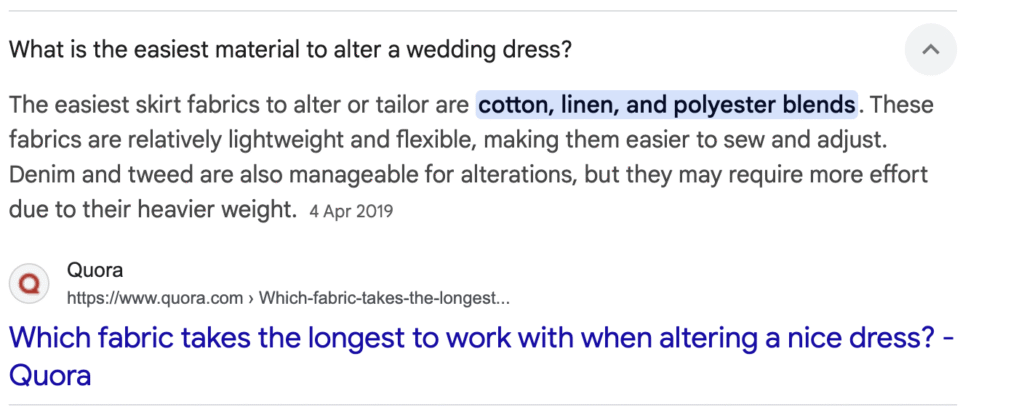
This style helps Google connect the question and answer, and makes it easier to feature your web page on the PAA boxes.
Aside from this, pay attention to the structure and format of your content.
Avoid dense paragraphs and long sentences. Instead, use lists and bullet points to breakdown steps and processes. If you’re writing a comparison article, use tables and even use a call-out word like “pro tip” to call people’s attention to important information.
Common Mistakes That Weaken Author Experience
While trying to demonstrate first-hand experience on your page, here are some mistakes you should avoid making, as they could hurt your ranking and dilute your credibility.
1. Using too many stock or AI-generated images
Stock photos are fine in moderation, but if every image on your page starts to look generic, it becomes harder to believe the content came from someone with real experience. AI generated visuals are prone to this, so, whenever possible, use real photos. Your readers will notice.
2. Misrepresenting credentials or outsourcing author voice
Publishing content under a fake name or using false qualifications is a quick way to lose credibility. Even if the writing is solid, readers and search engines will eventually pick on this disconnect.
Avoid listing someone as a “certified expert” unless they are, and only ghostwrite in YMYL niches if the author is involved throughout the process and approves the content.
3. Skipping schema or structural markup
You don’t need to be a developer to add basic schema, but skipping it altogether limits how search engines understand your content.
And with AI overview and featured snippets taking a permanent position on the first page of the SERPs, schema markup is your gateway to standing a chance to be part of the referenced sources.
Here’s a list of tools to help you implement schema markup:
- Use this Structured Data Markup Helper to add structured data markup to a sample web page.
- Run your URL through the Rich Results Test portal to see what Google rich results can be generated for your page.
- Use the Schema.org Markup Validator to test all types of markup, without Google-specific validation.
Read more about schema markup and how to create one for your website.
Conclusion
Personal stories, expert interviews, case studies, and verified testimonials are important elements of quality writing. They help you build trust and credibility, especially in high-stakes topics on health, law, and finance.
They also help search engines recognize if your content is accurate, helpful, and meets search intent. The more trustworthy you seem, the better for your rankings, your author authority (across the web), and the trust your readers will have.
